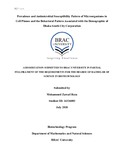| dc.contributor.advisor | Khan, Kashmery | |
| dc.contributor.author | Reza, Mohammed Zawad | |
| dc.date.accessioned | 2020-01-15T10:52:56Z | |
| dc.date.available | 2020-01-15T10:52:56Z | |
| dc.date.copyright | 2018 | |
| dc.date.issued | 2018-07 | |
| dc.identifier.other | ID 14336003 | |
| dc.identifier.uri | http://hdl.handle.net/10361/13557 | |
| dc.description | This thesis is submitted in partial fulfillment of the requirements for the degree of Bachelor of Science in Biotechnology, 2018. | en_US |
| dc.description | Cataloged from PDF version of thesis. | |
| dc.description | Includes bibliographical references (pages 125-129). | |
| dc.description.abstract | Mobile phones are currently one of the mostly used electronic devices and it is used by people from almost every walk of life. Along with that, usage of mobile phone is increasing with time passing by due to its availability and efficiency. As a result, the developing nations of the world are also embracing this technological wonder, and since Bangladesh has also found the golden touch of technology, mobile phones have climbed up to the top spots of our priority list. We take everywhere with us, use it all the time. All these occurrences raise the question of potential threats that come from mobile phones. One of those threats would be the transmission of pathogenic microorganisms from cell phones and their potentiality to act as vectors. With this in mind, the demography of Dhaka South City Corporation was selected to observe the prevalence of organism amongst the cell phones of the population and isolate and identify a group of potentially disease-causing organisms. A total of 110 mobile phone samples were included in this study for isolation of bacteria. 95% of the cell phones were found to be contaminated with bacteria and 216 bacterial samples were isolated from the mobile phones. Out of these colonies, we found Staphylococcus spp.(47.6%), Bacillus spp.(10.1%), Micrococcus spp.(19.09%), E. coli (20.3%) and fecal coliforms (12.03%). It was found that the participants who used cell phones while eating, used the cell phones inside washrooms, shared their cell phones with other persons and used the cell phones while being sick had more potentially pathogenic microorganisms than the participants who did not. It was also found that the participants who cleaned their cell phones everyday with any commercially available cleaning agent such as 70% ethanol, hand sanitizer or even commonly available liquid hand wash had no microorganisms present in them. Also, it was found that personal hand hygiene and cell phone hygiene is very important and also washing of hands before and after handling of food and phone decontamination should be adopted by people of Dhaka City to prevent cross and self-contamination by these bacteria. Regular usage of commercially available solvents are also recommended to be used regularly as they are actively capable of removing bacteria from the surface of cell phones, thus keeping it clean. | en_US |
| dc.description.statementofresponsibility | Mohammed Zawad Reza | |
| dc.format.extent | 129 pages | |
| dc.language.iso | en | en_US |
| dc.publisher | Brac University | en_US |
| dc.rights | Brac University theses are protected by copyright. They may be viewed from this source for any purpose, but reproduction or distribution in any format is prohibited without written permission. | |
| dc.subject | Microorganisms | en_US |
| dc.subject | Dhaka South City Corporation | en_US |
| dc.title | Prevalence of microorganisms in cell phones and the behavioral pattern associated with the demographic of Dhaka City (South) | en_US |
| dc.type | Thesis | en_US |
| dc.contributor.department | Department of Mathematics and Natural Sciences, Brac University | |
| dc.description.degree | B. Biotechnology | |

